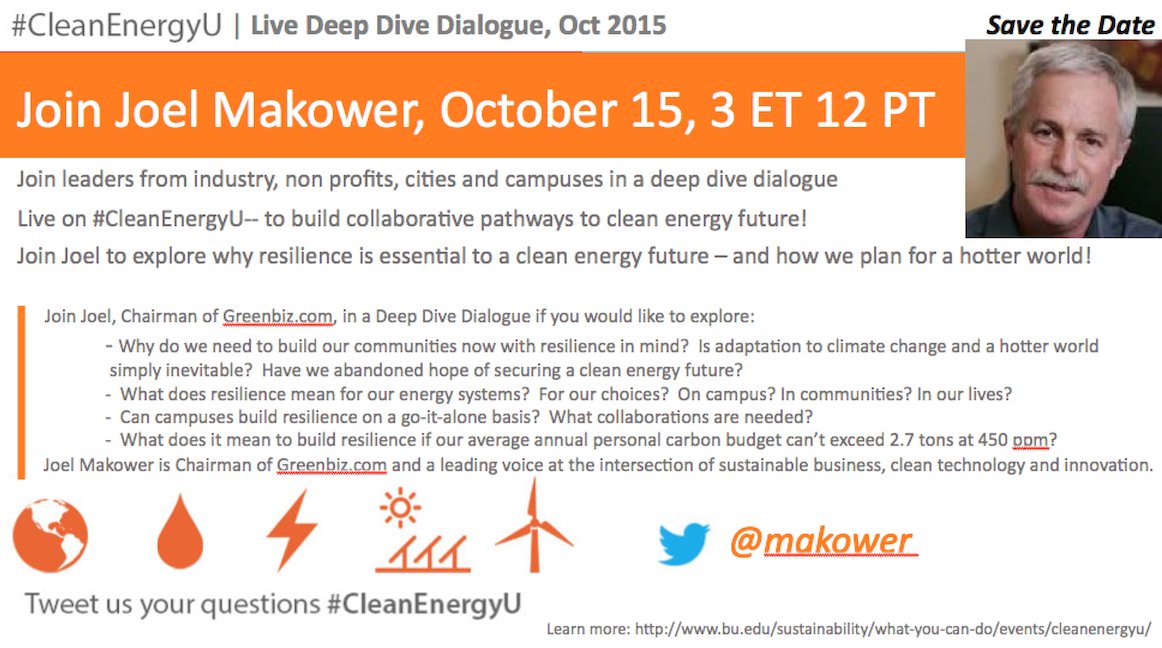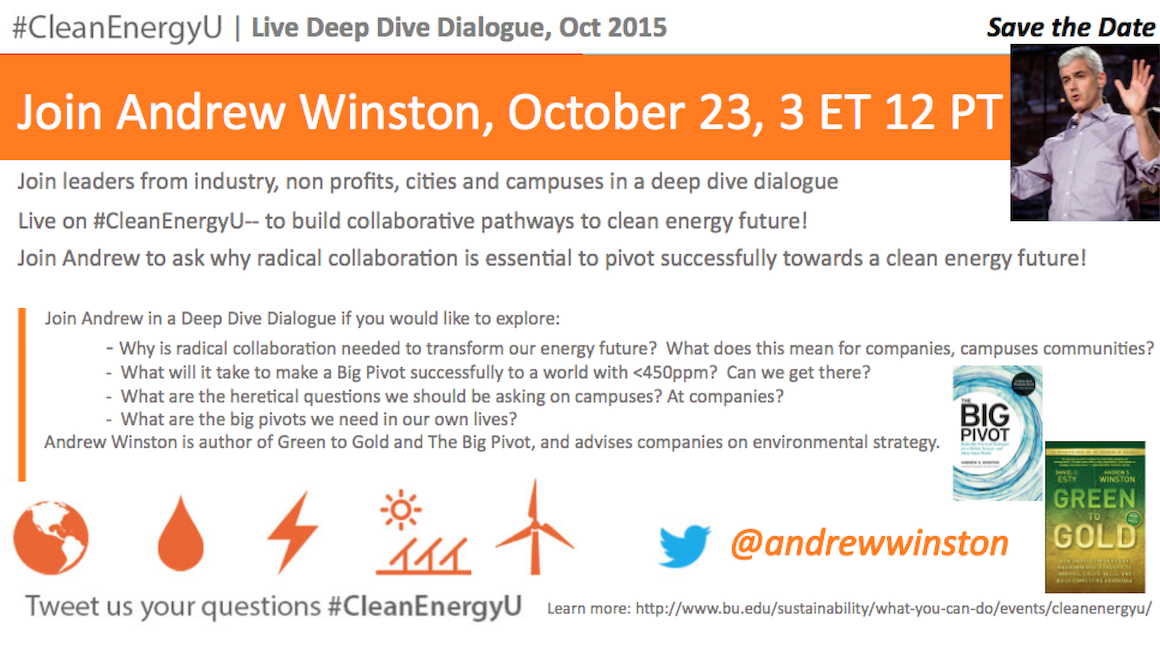Code Green Solutions


How do we collaborate towards a clean energy future, asks the #CleanEnergyU dialogue this month?
Author of “Green to Gold” and the “Big Pivot,” Andrew Winston’s response? Be radical in your collaborations…
You mean like:
For real? Is anyone really doing this?
Andrew is clear that to address the systemic challenges we face, like climate change, we need to make a Big Pivot as a species: we need to ask ourselves heretical questions, incorporate natural capital, like carbon, into all our finance and investment decisions – and collaborate in new radical ways, like WalMart and Target are already pursuing.
And the fruits of these efforts? We may be able to build “Resilience in a Hotter World” – the capacity to be “anti-fragile” by building diversity and redundancy into our companies, communities and lives – in ways that not only defend our planet but can even outperform our competitors.
Wondering how you best build resilience? How to pursue radical collaboration?
Join Joel Makower to examine resilience during his #CleanEnergyU Deep Dive Dialogue at 3pm ET today Oct 15 via twitter at #CleanEnergyU: why resilience is important and how we build it to secure a cleaner energy future…
Check out and join our #CleanEnergyU Tweetathon discussions on Oct 20/21 from 12-4pm ET when student and clean energy leaders will be asking how radical collaborations like Andrew proposes can actually be pursued together …
…
And engage with Andrew Winston in our last #CleanEnergyU Deep Dive Dialogue at 3pm ET on Friday Oct 23 to ask him your heretical questions in order to build your radical collaboration solutions – in our shared quest towards a #CleanEnergyU future!
—
How Target is Taking Sustainable Products Mainstream (and Working with Walmart)
By Andrew Winston
For years, the answer to the question “Do people really want to buy more sustainable products?” was a profound “sort of.” Surveys consistently show that we aspire to buy responsibly, and we even say we’ll pay more for environmental or socially preferable products. But purchase intent does not always translate to real sales, and companies have often struggled to make sustainable products more mainstream.
That seems to be changing. Kate Heiny, who very recently departed as the director of sustainability at Target, told the crowd at this summer’s sizable Sustainable Brands conference that: “With their words and wallets, our customers are asking for more [sustainable products].”
The numbers bear this out: Within Target’s “naturals and organics” category, sales grew 17% last year, four times faster than its total grocery sales. And it’s not just happening at Target. A new Conference Board study, as CFO magazine reported, reveals some startling growth in greener products at a dozen big companies like Kimberly-Clark, Dow, GE, Siemens, Toshiba, and more.
So why are sustainable products surging now? I’ve been in contact with Heiny and her team at Target over the last year about the program she helped build to drive product innovation and more sales. Our discussions focused on three reinforcing elements.
First, the company painstakingly built its own Sustainable Product Standard. Working with UL’s Good Guide system, Target scores 7,000 products on a 100-point scale, with 50 points at stake related to the toxicity of ingredients. Additional points are awarded for reduced packaging impacts (can consumers recycle it?) and transparency (that is, sharing all ingredients on the product labels with deductions for things like “fragrance” without the details). The list of no-no ingredients is long — 1,600 chemicals tracked or regulated by NGOs and governments around the world.
It’s unclear whether Target will really eliminate low-scoring products, but the company has certainly promoted the highest scoring options – and that’s part two of the story. Under the banner of “Made to Matter,” Target is showcasing good-guy products, including usual suspects like Ben & Jerry’s, Annie’s, Stonyfield, Seventh Generation, and Method, but also some lesser-known players. In total, these brands are projected to reach revenues of $1 billion at Target alone this year.
With this level of topline growth, it’s no wonder that Target wants more options.
This gets us to part 3, an unusual initiative with the company’s arch-rival Walmart to improve the sustainability of the entire personal care value chain. But in order to understand their unlikely collaboration, it’s important to consider the competitive strategic elements of Target’s approach.
Target has, until recently, lagged Walmart on building its brand around sustainability issues. For nearly a decade, Walmart has made environmental progress a priority, in word and in deeds. The company has made significant efforts to improve store operations with their impressive energy efficiency work and the purchase of more solar power than any entity in the U.S. besides the military. For years, the retail giant has also applied imposing pressure on suppliers to reduce and improve packaging, cut carbon, and much more.
While Target has also reduced its impacts and committed to using much more solar power, it always seemed like the company was searching for its unique, brand-appropriate approach to environmental and social issues. Now Target has clearly focused its attention on consumers. Making sustainable products more accessible is a great fit for Target — after all, the company was dubbed Tar-jay years ago after its many successful forays into making high-end design affordable.
This all isn’t to say that Walmart has sat still on the consumer front — a few months ago it launched an important experiment on walmart.com to highlight mainstream products “made by sustainability leaders,” as they called it. But by and large, for years, Walmart has taken, in my view, a mainly operational, cost-reducing, brand-fitting approach to sustainability.
Target is, by comparison, focusing much more about the downstream part of the value chain. But of course, for a retailer to provide better products to customers, it has to work with suppliers and, now it seems, even with competitors.
Target and Walmart launched the Personal Care Sustainability Summit last year, and invited the largest players in the $74 billion market for lotions, soaps, and other beauty and grooming products to join them. I attended the two main meetings thus far, first in Chicago in 2014 and then in Brooklyn earlier this year. In one room, at the behest of the two big guns of retail, sat the largest consumer product, chemical, and fragrance companies.
The collaboration, which the NGO Forum for the Future is managing, has high aspirations. They’ve developed ongoing working groups to seek solutions on critical themes like information sharing; agreements on science-based definitions for safety/toxicity on ingredients; and — in the truly unusual part — group R&D across the value chain to develop new, safer classes of chemicals (particularly in preservatives). Over the last five years, Walmart and Target have increasingly become what I call “de facto regulators” of chemicals through their programs to limit certain ingredients. But now they’re actively pushing the supply chain to invest better options.
When I asked Target why they would go to this much trouble, they saw the big picture. As Laysha Ward, Target’s EVP and Chief Corporate Social Responsibility Officer said, “We realize that we can leverage our scale, influence and resources to improve the way products come to market and drive transformational change for our business and society.” But again, it’s not solely a change-the-world discussion – Target is seeing real customer demand. As Heiny put it, “It is quite clear that our guest is asking for these products, which is why we’re having these summits.”
In all, Target’s growing focus on the consumer end of the equation demonstrates some key elements of a modern sustainability strategy, including giving customers options that are not just greener, but better; data-driven analysis and transparency; value chain and systems thinking; and radical collaboration with suppliers and even competitors.
Anytime the giants of an industry really start competing and collaborating on sustainability, it’s a very good development. Let’s hope we consumers continue to play a positive role — we may be key to companies making big, important changes.
—
Inspired to collaborate more radically now towards a #CleanEnergyU future?
Join our #CleanEnergyU Tweetathon with student and clean energy leaders on twitter via #CleanEnergyU on Oct 20/21 from 12-14 ET when we’ll be exploring how radical collaborations like Andrew proposes can actually be pursued together …
And engage with Andrew Winston in our last #CleanEnergyU Deep Dive Dialogue at 3 ET on Friday Oct 23 to ask him your heretical questions and how to build your radical collaboration solutions –– in our shared quest towards a #CleanEnergyU future!